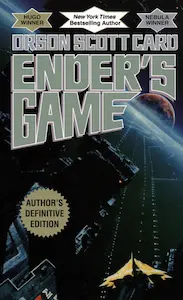Ender’s Game - Summary
Orson Scott Card

Introduction
“Ender’s Game” is a science fiction novel written by Orson Scott Card. Published in 1985, it quickly became a beloved classic within the genre. The story follows the journey of Andrew “Ender” Wiggin, a young boy who is chosen to train at the Battle School, a military institution in space. As the novel unfolds, Ender faces numerous challenges, both physical and psychological, as he prepares to lead humanity in a desperate battle against an alien species known as the Formics. With its compelling narrative and thought-provoking themes, “Ender’s Game” captivates readers and explores the complexities of war, leadership, and the blurred lines between good and evil.
The World of Ender
In “Ender’s Game,” Card creates a vivid and immersive world set in a future where Earth is under the constant threat of invasion by the Formics. The novel begins with Ender as a six-year-old child, living in a society that strictly controls family size due to overpopulation concerns. Ender is a Third, a third child in a family where only two children are allowed. This societal restriction sets the stage for Ender’s isolation and the pressure he faces to prove his worth.
The Battle School
At the age of six, Ender is selected to attend the prestigious Battle School, a space station where exceptionally gifted children are trained to become military commanders. The Battle School is a microcosm of the larger conflict between Earth and the Formics, and it serves as a testing ground for Ender’s abilities. Here, Ender encounters a hostile environment where he must navigate complex social dynamics and face both physical and psychological challenges.
The Mind Game
One of the most intriguing aspects of “Ender’s Game” is the inclusion of a virtual reality game called the Mind Game. Designed to test and train the students’ strategic thinking, the Mind Game becomes an integral part of Ender’s journey. Through the game, Ender explores his own psyche, confronts his fears, and gains insights into his true potential. The Mind Game serves as a metaphor for the blurred lines between reality and simulation, raising questions about the nature of war and the morality of the choices made within it.
The Battle Room
The Battle Room is a zero-gravity training arena within the Battle School, where students engage in mock battles using a combination of teamwork and strategic thinking. Ender’s exceptional leadership and tactical skills quickly set him apart from his peers. He develops innovative strategies, such as using unconventional formations and exploiting the enemy’s weaknesses. Ender’s ability to think outside the box and adapt to ever-changing circumstances makes him a formidable opponent.
The Complexity of Morality
Throughout the novel, Card explores the moral implications of Ender’s actions. Ender is manipulated by the adults around him, who believe that the ends justify the means in the fight against the Formics. As Ender progresses through his training, he becomes increasingly aware of the consequences of his actions and the true nature of the war he is being prepared for. This exploration of morality adds depth to the story, forcing readers to question the ethical boundaries of warfare and the sacrifices made for the greater good.
Isolation and Loneliness
Ender’s journey is marked by a profound sense of isolation and loneliness. As a child prodigy, he is separated from his family and thrust into a world where he struggles to form meaningful connections. Ender’s isolation intensifies as he rises through the ranks, and he becomes burdened by the weight of responsibility placed upon him. This theme of isolation highlights the sacrifices Ender must make in order to fulfill his destiny and protect humanity.
The Unveiling of Truth
As the story progresses, Ender discovers that his training at the Battle School is not just a game but a preparation for a real war. The truth behind the simulations and battles is revealed, challenging Ender’s perception of reality and his role in the conflict. This unveiling of truth adds a layer of complexity to the narrative, blurring the lines between right and wrong and forcing Ender to confront the consequences of his actions.
The Twist Ending
The climax of “Ender’s Game” delivers a shocking twist that leaves readers questioning their own assumptions. Without spoiling the ending, it subverts expectations and challenges the notions of heroism and victory. Card’s ability to surprise and provoke thought in the final chapters solidifies “Ender’s Game” as a masterfully crafted novel that lingers in the minds of readers long after the final page.
Conclusion
“Ender’s Game” is a captivating and thought-provoking science fiction novel that explores the complexities of war, leadership, and morality. Orson Scott Card’s skillful storytelling and the compelling journey of Ender Wiggin make this book a must-read for fans of the genre. Through its immersive world-building, complex characters, and unexpected twists, “Ender’s Game” continues to captivate readers and inspire discussions about the blurred lines between good and evil.